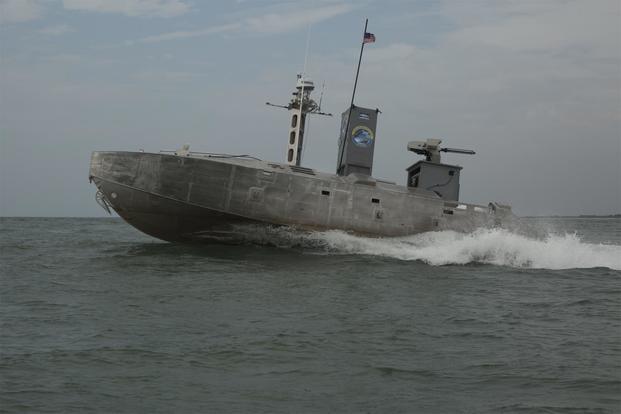The Navy is getting ready to roll out a new force structure assessment that will set the bar for the fleet size for years to come, but it won't include new high-tech unmanned vessels the service has been testing.
Drone ships will not be included in the Navy's next ship count goal, which Chief of Naval Operations Adm. Michael Gilday said will "come out in a couple of weeks." Gilday spoke about the new force structure review on Tuesday at the Surface Navy Association's national symposium outside Washington.
The Navy has been working closely with the Marine Corps to determine the best size for the future fleet, Gilday said. Marine leaders, including Commandant Gen. David Berger, have said unmanned surface and underwater vessels will be vital in future Marine Corps operations.
"We need to pursue unmanned technologies and we need to solve tough technology and policy issues associated with unmanned instead of running away from it," Gilday said.
Gilday said unmanned vessels acquired by the Navy would be in addition to the final force-structure review count that could be released this month. Much of the technology is still in development.
Acting Navy Secretary Thomas Modly previously said the next force structure review is likely to exceed the 355-ship fleet last called for in 2016. That assessment was completed years before the Defense Department released its National Defense Strategy, which calls for building a more lethal force that can take on a peer threat.
Related: Acting Navy Secretary Hints at Naval Force Larger Than 355 Ships
The Navy is investing heavily in unmanned surface and underwater vessels. The department's last budget proposal included a request for $400 million in fiscal 2020 to build a pair of large unmanned surface vessels. And budget documents showed the Navy wanted a total of $2.7 billion to build 10 of the ships over the next five years.
The Navy and Marine Corps experimented with the 40-foot long autonomous Expeditionary Warfare Unmanned Surface Vessel during an exercise last year. The Navy also last year sent a 132-foot long self-driving ship from California and Hawaii and back again with barely anyone onboard for much of its voyage.
Gilday said the Navy and Marine Corps are working closer now that at any point in his career, and both services will continue experimenting with unmanned technologies.
As that new technology is developed and makes its way into the fleet, the CNO said the force-structure assessment could change.
"It's not something that we want to leave on the shelf," Gilday said. "... You will see some changes in those numbers."
-- Gina Harkins can be reached at gina.harkins@military.com. Follow her on Twitter @ginaaharkins.
Read More: Navy's Plans for Unmanned 'Ghost Fleet' Remain Shrouded in Secrecy












